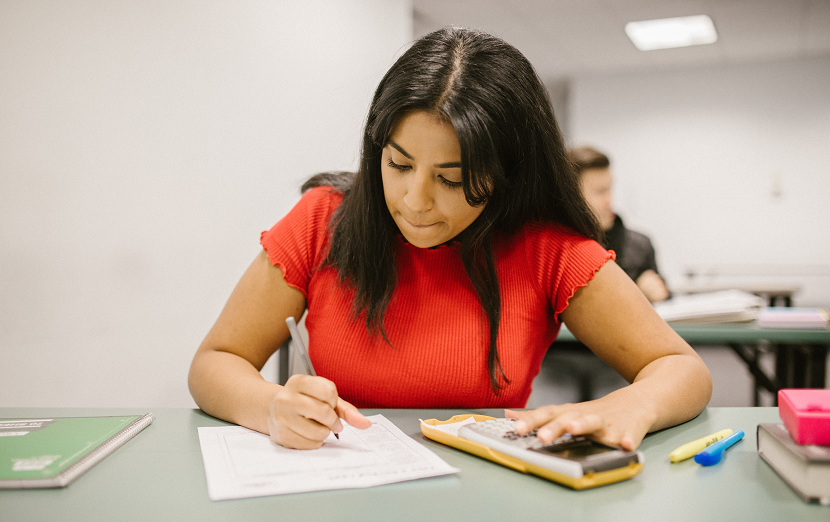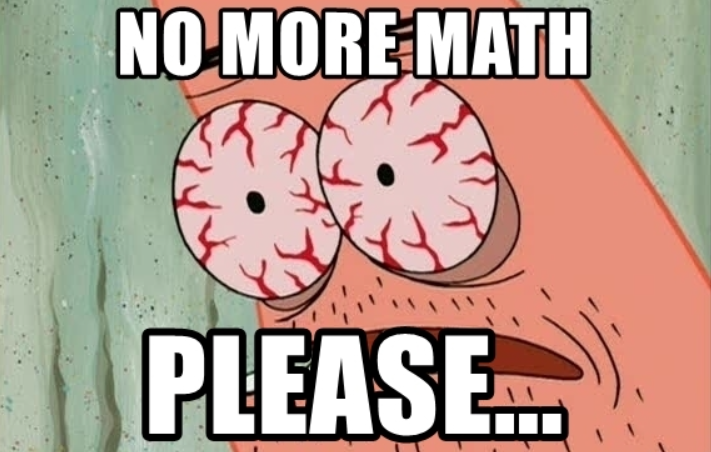I know what you’re thinking; of ALL the things to study for on the ACT math section, I want you to look at the “easiest” topic of them all: fractions, decimals, and percentages. It’s no doubt that all students are familiar with this elementary-level topic and, well, how hard can one part of a whole really be?

You see, the difficulty in these types of problems on the ACT math section oftentimes isn’t in the computation itself, but rather with understanding the problem. ACT math problems are designed to make you take the easiest route down: your brain will scan the numbers in the word problem and WANT to do the simplest operation to find the solution. Here’s a quick example:
In 1991, Sally improved her long jump distance by 10%. In 1992, she improved on the previous year’s distance by 20%. By how much did Sally improve on her 1990 long jump distance?
a) 30%
B) 32%
C) 33%
D) 25%
Most students will see a 10% and 20% and add them together to choose a 30% increase, but this is WRONG. With straightforward wording and simple-seeming numbers, this is just one of several examples of how the ACT math section tricks you into setting up the problem wrong.
ALGEBRA NEVER FAILS US IF WE SET THINGS UP CORRECTLY!
With this mantra guiding this post, let’s quickly review the mechanics of fractions, decimals, and percentages.
Fractions, decimals, and percentages review on ACT math
Fractions
Intuitively, fractions can be thought of as either a part of a whole or a ratio of two numbers. For example, when we look at ¾, when we think of it as a part of a whole, we can imagine it representing 3 slices of a pizza that is split into four parts. We can now take this fraction and apply it to multiple different pizzas. Say that there is already a pizza but half of it has already been eaten. Since you love practicing fractions and eating pizza, you want to eat only ¾ of this half-eaten pizza. All we have to do in this case is multiply ¾ by ½ to get ⅜, and with this product, we now know that we have to cut the remainder of this pizza into 8 slices and eat three of those slices.
For the ACT math section, be sure to know how to:
- Simplify fractions
- Convert back and forth between mixed numbers and improper fractions (ex. 3 ⅓ to 10/3)
- Add, subtract, multiply, and divide fractions
Decimals
Decimals are numbers that fall between integers and are described as digits following a decimal point. We can describe these parts based on units of tens (tenths, hundredths, thousandths, and on) and use them to convert back to fractions! We can convert 0.1 to a fraction by dividing 1 by 10, 0.01 by dividing 1 by 100, and so on. If we have something like 1.01, we can convert to a fraction by writing out the mixed number and going to an improper fraction if needed: so 1 and 1/100ths will thus simplify to 101/100. Going from fractions to decimals, on the other hand, is much simpler. Simply divide the numerator by the denominator and you have your decimal!
For the ACT math section, be sure to know how to:
- Convert from a decimal to a fraction and vice versa
- Add, subtract, multiply, and divide decimals
Feeling Overwhelmed? Get 1-on-1 ACT Help from a Test Geek Tutor
Percentages
With percentages, we can represent them as both decimals and fractions, but it can be a bit tricky figuring out what exactly to do with these fractions and decimals. 1/1 denotes 100% in percentage terms, so if we want to convert from a fraction to a percentage, we can simply take the fraction and multiply it by 100% (ex. ¾ multiplied by 100% gives us 75%). Because decimals represent fractions just in a different format, the same process goes for them! If we want to convert 0.3 to a percentage, simply multiply by 100% to get us 30%.
To go from percentages to decimals and fractions, we simply do the opposite of multiplying by 100: dividing by 100! Let’s convert 15%: 15/100 simplifies to 3/20, giving us our simplified fraction, and simplifying it to a decimal gives us 0.15!
For the ACT math section, be sure to know how to:
- Convert between percentages, decimals, and fractions

Bring on the practice problems!
So how should we approach test problems? Like I mentioned earlier, the difficulty mostly comes with setting up the calculation, not the actual calculation (silly mistakes, on the other hand, are a different topic). So in order to set up an accurate problem, we must understand the problem completely. For these next few practice problems, we’ll be following three main steps.
- Understand the context of the math.
This is undoubtedly the hardest part, but if you genuinely understand the context of the arithmetic you’re doing, the algebra won’t fail! Read through the question and identify what operations you’ll need, and don’t be afraid to work with some test numbers.
- Generalize a solution.
After developing context, you should have a general gist of the steps you’ll need to do. For example, what will go on both sides of the equation? What are the steps in finding x percent of this? You’ll be asking a general question, but you’ll also be providing a general question.
- Apply the general solution.
With your general outline, go into the problem and apply the numbers!
The steps sound pretty broad, so let’s get into some practice. To begin, let’s actually go back to Sally and her long jump from earlier.
In 1991, Sally improved her long jump distance by 10%. In 1992, she improved on the previous year’s distance by 20%. By how much did Sally improve on her 1990 long jump distance?
a) 30%
B) 32%
C) 33%
D) 25%
- Understand the context of the math.
In 1991, she improved her jump by 10%. Now, what does this mean mathematically? When we increase a number by 10% of it, we basically find 10% of that number and then add it on to what we had before. For example, if we increase 10 by 10%, we see that 10% of 10 is 1 (aka 0.1*10), so increasing it by 1 is simply 10+1, or 11.
- Generalize a solution
From our context above, we can think of increasing a number by 10% as multiplying that number by 1.1: in other words, we keep the whole number and add 10% of it, thus the 1 and 0.1 portion. We can generalize an increase by x% as multiplying that number by 1+(x/100).
- Apply the general solution
Now that we know how to increase a number by x%, let’s work through the entire problem.
The problem never specified her initial distance, so let’s call it “d.” An increase in 10% means multiplying d by 1.1, so in 1991, her distance is 1.1d. In 1992, she then improved her PREVIOUS year by 20%, so we know that we are going to multiply the previous year by 1.2 (remember, 1+ 20/100 is 1 + 2/10). When we multiply 1.2(1.1d), we get a product of 1.32d.
Okay, so if we know that 1.1d represents a 10% increase in d, we know that 1.32d represents a 32% increase. We found our answer, B!

Let’s work through a few more problems.
For all real numbers x such that x is NOT equal to 0, 7/8 + 10/x = ?
a) 17/8x
B) 70/8x
C) 17/(x+8)
D) (7x+80)/8x
- Understand the context of the math.
So it’s clear that we’re dealing with fraction addition, but we look at the answer choices and know that we aren’t solving for x. Instead, we’re going to simplify these two terms down into one and look for the correct simplification. Remember, even though this question isn’t nearly as complicated as the last one, developing context allows you to read through the question more clearly!
- Generalize a solution.
With fraction addition, it’s important to have a common denominator. How do we find common denominators? Common multiples! When adding ½ and ⅓, we can find the common denominator by multiplying 2 and 3 together, so in this case, we can find our common denominator doing the same thing. We’ll have to make sure to adjust the numerators to keep the original value the same, and then we’ll add.
- Apply the general solution.
Our common denominator will be 8x, so let’s start by simplifying the first fraction. How do we go from 8 to 8x? We multiply by x, so this means that in order to keep the proportions the same, we’ll also have to multiply the numerator by x. After all, 7x/8x simplifies to ⅞ again. With the second fraction, we have to multiply x by 8 to get to 8x, so this means we also multiply the numerator by 8. In doing so, we know have 80/8x, which we know simplifies back down to 10/x.
We have our simplified fractions, 7x/8x and 80/8x, so let’s add! We end up with (80+7x)/8x. This is answer choice D!
The decimal construction of 5/13 repeats and can be written as 0.384615384615… and so on. What is the 99th digit to the right of the decimal point in this decimal construction?
a) 1
B) 3
C) 4
D) 5
- Understand the context of the math.
We actually don’t need to calculate any numbers here, in fact, they give us both the fraction and decimal format. However, they are asking us for the 99th digit given the repeating decimal sequence. This means that this will be more of a logic and reasoning problem that won’t have as much calculation. Knowing this, let’s devise a general plan.
- Generalize a solution
We notice that the repeating sequence consists of 6 terms, “384615” before it repeats again. Generally, we would write out all of the terms and count until the 99th term, but we don’t have time for that on the ACT. However, we do know that there will be several repeating 6-term chunks that will appear among these 99 terms, so let’s save ourselves some work! We’ll probably find how many of these chunks there are, and with much less terms to count, we’ll determine the 99th term from there.
- Apply the general solution
Let’s see how many times 6 goes into 99.
99/6 gives us 16 remainder 3, so we know that 16 ENTIRE repeating chunks appear in our count to 99. This saves us SO much work, because now we know that we have just three more terms left to count. Better yet, we know that we’re starting at the beginning of the sequence because we we accounted for the ENTIRE chunk of repeating terms. Count one lands on three, count two ends on 8, and count three ends on 4, so our final answer would be C.
Alright. One more together.

30% of 350 is 50% of what number?
a) 100
B) 105
C) 210
D) 135
- Understand the context of the math.
Not too much context to understand here, the problem is pretty straight forward! We just have to find a number given some information on its percentages of other numbers.
- Generalize a solution.
We can split this problem up into two parts. First, we’ll have to find 30% of 350. However, we’re then told that the number we found is going to be 50% of an unknown number that we’ll call y. We’ll have a concrete value when we find 30% of 350, so this means that we’ll have one equation and one unknown – we can solve that!
- Apply the general solution.
Let’s start by finding 30% of 350. 0.3*350 gives us 105, so now we can move on to the next step! We know that finding 50% of a number means multiplying it by 0.5, so let’s set up an equation. We’re trying to find an unknown y, and we know that 50% of y is equal to 105. Thus, 0.5y = 105, so let’s solve for y! 105/0.5 essentially means multiplying 105 by 2, so our final answer is C, 210.
Final Thoughts
With the ACT math section covering several tricky topics such as trigonometry and planar geometry, it’s easy to forget about the fundamentals. With topics that have simpler calculations, you’ll see that the ACT math section will do more to trick the student into setting up the wrong solution. Read through each problem carefully, let the math guide your solution, and don’t forget to polish topics that seem “easy” at first!











Comments